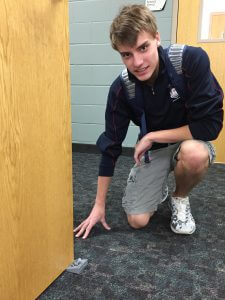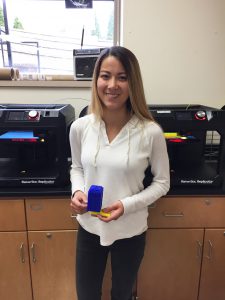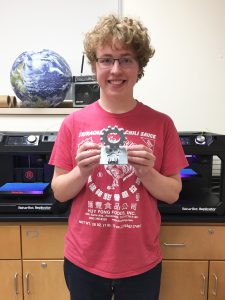May 26, 2017
 Upper School students in Engineering & Design were recently set free to ask two very important questions that get at the heart of science and the core of engineering: What is your need and how can I help? Students were then able to produce real solutions in 3-D.
Upper School students in Engineering & Design were recently set free to ask two very important questions that get at the heart of science and the core of engineering: What is your need and how can I help? Students were then able to produce real solutions in 3-D.
Marc Shapiro, a Mounds Park Academy science faculty member and MPA’s FIRST Robotics coach, developed this project, which had two goals: to introduce students to 3-D printing and provide a useful device to an MPA faculty or staff member.
To determine genuine needs, Shapiro surveyed faculty and staff via email about what problems they had with their respective workspaces or how they wanted to enhance their classrooms. He compiled a list that he gave his students to review. For some teachers, those old-school rubber door stops just weren’t working; others wanted chairs that didn’t wobble. Each student ranked the projects according to interest, then Shapiro made the matches and let the students take it from there.
Over the course of several weeks, the students met with their “clients,” to learn much more. After evaluating the problems to solve, the students took to their computers to design the solutions. Projects ranged from a replacement part for a piece of Ikea furniture to a Tardis door stop, from a segmented window cover to geometric shapes for a math class. Shapiro himself requested a wall-mounted cable holder to corral electric cords. Beginners were introduced to a basic design program, while students who already had experience with 3-D design software were allowed to use the more advanced design program of their choice.
The students then printed the solution on one of the school’s 3-D printer. The printing process took anywhere from a few minutes to several hours, depending on the size and complexity. With their prototypes in hand, the students shared the product with their “clients” to see if they performed as expected. If necessary, they redesigned and reprinted the part, working through the details until they completed the project or determined it wasn’t feasible.
Deep Levels of Interdisciplinary Learning Far Beyond Engineering
 While Shapiro has taught Engineering & Design for three years, he had never incorporated a project that had students designing products for “clients.” But he absolutely will again.
While Shapiro has taught Engineering & Design for three years, he had never incorporated a project that had students designing products for “clients.” But he absolutely will again.
This project involved deep levels of interdisciplinary learning, starting with the interaction students had with their clients. Stepping away from the computer is a central aspect of all engineering endeavors. Students were set free to understand complex problems and meet human needs. According to Shapiro, communication and creative thinking are as critical to engineering as STEM skills.
Beyond the real-world, practical application of the project, Shapiro saw that it benefited students outside of their academic growth.
“Having to design a functional item for an adult in the building made the students accountable in a way that’s different from a typical classroom assignment,” said Shapiro. “In addition, the students gained a great sense of satisfaction from taking the project from idea to reality, and seeing it meet its expectations when it came to fruition. This exemplifies engineering at Mounds Park Academy and in the real world.”
Rigor with Purpose
MPA is a school with a calling to make the world a better place, including developing students who are able to solve problems with practical applications as they did in Shapiro’s Engineering & Design class. This project exemplifies what is at the core of an MPA education: rigor with purpose. MPA doesn’t just educate students to perform well on a test or secure admission to a highly competitive college, although both of those things happen. Its deeper purpose is to cultivate students who are capable of making positive change, who will be our future leaders in government, business, education, and STEM.
Part of what makes rigor with purpose possible at MPA is the flexibility that MPA faculty have to develop creative assignments. They aren’t teaching to a set curriculum or to a standardized test. MPA teachers like Shapiro have the freedom to develop assignments like this that will meet their learning objectives and the needs of the students.
While some of the projects proved unfeasible, several are complete and function as intended such as the door stop that Bennett Henke created for Ms. O’Keefe in first grade. Or the chair-leg caps that Ajay Manicka created for Ms. Stacy and her fourth graders.
Cross-grade Connections
Stacy had been struggling with the blue plastic chairs in her classroom. Some of the chairs’ legs were uneven. Active fourth graders would shift from one leg of the chair to the other, accentuating the imbalance. When she was asked what problem she’d like to fix in her classroom, she immediately thought of the chair legs.
Over the course of project, Ajay came to Stacy’s classroom to test multiple renditions of his chair-leg ends. Stacy said he was “respectful, enthusiastic and ready to head back when the first one didn’t quite fit.” By the end of the project, Ajay finally created a chair-leg end that would work.
The tenth-grade student was excited. “Ajay’s enthusiasm would certainly lead me to support his endeavor, even if I had to buy the things,” said Stacy.
Stacy thought her students would love to hear the story behind the new bright-yellow chair-leg ends that she was going to debut in her classroom straight from the engineer. The 20-year MPA teaching veteran invited Ajay to come talk to her class, and he enthusiastically agreed.
Ajay told Stacy’s students about the engineering course and the specific project. He used a chair to show them how he measured the diameter of the leg, discussed the balance problems caused by the angle of the other feet, and then secured his invention to the chair leg.
“One of the Sweetest Moments of my Career”
An experienced student of MPA’s interdisciplinary approach to learning, Ajay shared his and Stacy’s plan to print the chair-leg ends as needed, tying it to an Earth Day discussion about waste. Ajay also solicited ideas from the students on how they could recycle the plastic bottoms if MPA was to ever replace the chairs all together. One idea was to put different emojis on the bottoms, and then allow students to use them to express their emotions and feelings about things.
At the end of his talk, Ajay invited one of the students to try out the bright-yellow chair-leg ends. Graham volunteered. With all of his classmates’ eyes on him, Graham sat down in the modified blue chair. Immediately, he smiled and gave it a fourth grader’s highest accolade: a thumb’s up.
“When Graham gave the chair-leg ends a thumps up, my students gave Ajay a standing ovation,” said Stacy. “It was perhaps one of the sweetest moments of my career.”